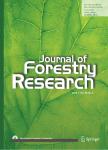Response of density-related fine root production to soil and leaf traits in coniferous and broad-leaved plantations in the semiarid loess hilly region of China
Response of density-related fine root production to soil and leaf traits in coniferous and broad-leaved plantations in the semiarid loess hilly region of China作者机构:State Key Laboratory of Soil Erosion and Dryland Farming On the Loess PlateauNorthwest A&F UniversityYanglingShaanxi712100People’s Republic of China College of ForestryNorthwest A&F UniversityYanglingShaanxi712100People’s Republic of China Institute of Soil and Water ConservationChinese Academy of Sciences and Ministry of Water ResourcesYanglingShaanxi712100People’s Republic of China
出 版 物:《Journal of Forestry Research》 (林业研究(英文版))
年 卷 期:2022年第33卷第3期
页 面:1071-1082页
核心收录:
学科分类:09[农学] 0903[农学-农业资源与环境]
基 金:The study was financially supported by the National Key R&D Program of China(2017YFC0504601)
主 题:Fine roots Black locust Chinese pine Semiarid Soil moisture Leaf area index
摘 要:Fine roots are the most active and functional component of root systems and play a significant role in the acquisition of soil resources. Density is an important structural factor in forest plantations but information on changes in fine roots along a density gradient is limited. In this study, plantations of black locust (Robinia pseudoacacia L.) and Chinese pine (Pinus tabuliformis Carr.) with four density classes were analyzed for the influence of soil and leaf traits on fine root growth. Fine root biomass increased with stand density. High fine root biomass was achieved through increases in the fine root production and turnover rate in the high-density black locust plantations and through an increase in fine root production in the pine plantations. In the high-density Chinese pine stand, there was a high fine root turnover which, coupled with high fine root production, contributed to a high fine root biomass. Overall, fine root production and turnover rate were closely related to soil volumetric water content in both kinds of plantations, while fine root biomass, especially the component of necromass, was related to soil nutrient status, which refers to phosphorous content in black locust plantations and nitrogen content in Chinese pine plantations. There was a close linkage between leaf area index and fine root dynamics in the black locust plantations but not in the pine plantations.



